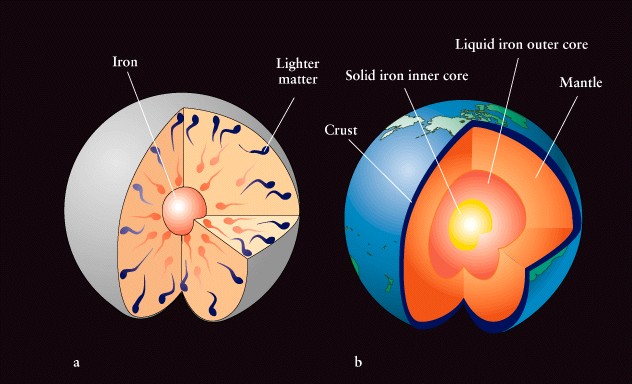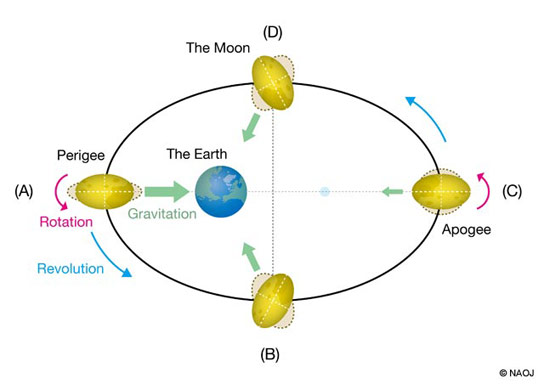
Ganymede, the largest moon in the solar system, also shows a great deal of cratering ( Figure 12.4). Ice on Callisto does not deform or flow like ice in glaciers on Earth. At the temperatures of the outer solar system, ice on the surface is nearly as hard as rock, and it behaves similarly. In thinking about ice so far from the Sun, we must take care not to judge its behavior from the much warmer ice we know and love on Earth. (credit a: modification of work by NASA/JPL/DLR credit b: modification of work by NASA/JPL/Arizona State University, Academic Research Lab) As the surface erodes even further, the icy spires eventually disappear, leaving impact craters exposed, as shown in the lower image. The spires are about 80 to 100 meters tall. (b) These high-resolution images, taken by NASA’s Galileo spacecraft in May 2001, show the icy spires (top) on Callisto’s surface, with darker dust that has slid down as the ice erodes, collecting in the low-lying areas. Astronomers believe that the bright areas are mostly ice, while the darker areas are more eroded, ice-poor material. (a) Jupiter’s outermost large moon shows a heavily cratered surface. You might say that this moon was stillborn, and it has remained geologically dead for more than 4 billion years ( Figure 12.3).Ĭallisto. Callisto is unique among the planet-sized objects of the solar system in the apparent absence of interior forces to drive geological change. The survival of these craters tells us that an icy object can retain impact craters on its surface. The surface of Callisto is covered with impact craters, like the lunar highlands. Yet Callisto seems to have frozen solid before the process of differentiation was complete. Only a little heating will soften the ice and get the process started, allowing the rock and metal to sink to the center while the slushy ice floats to the surface. It should be easier for an icy body to differentiate than for a rocky one because the melting temperature of ice is so low. This surprised scientists, who expected that all the big icy moons would be differentiated. We can tell that it lacks a dense core from the details of its gravitational pull on the Galileo spacecraft. Unlike the worlds we have studied so far, Callisto has not fully differentiated (separated into layers of different density materials).

Callisto can show us how the geology of an icy object compares with those made primarily of rock. This tells us that Callisto has far less of the rocky and metallic materials found in the inner planets and must instead be an icy body through much of its interior. Yet its mass is only one-third as great, which means its density (the mass divided by the volume) must be only one-third as great as well. Its noontime surface temperature is only 130 K (about 140 ☌ below freezing), so that water ice is stable (it never evaporates) on its surface year round.Ĭallisto has a diameter of 4820 kilometers, almost the same as the planet Mercury ( Figure 12.3). Callisto’s day thus equals its month: 17 days. Like our own Moon, Callisto rotates in the same period as it revolves, so it always keeps the same face toward Jupiter. Its distance from Jupiter is about 2 million kilometers, and it orbits the planet in 17 days. This makes it a convenient object with which other, more active, worlds can be compared. We begin our discussion of the Galilean moons with the outermost one, Callisto, not because it is remarkable but because it is not. Table 12.1 Callisto: An Ancient, Primitive World We include Titan, Saturn’s one big moon, here for comparison.) Table 12.1 summarizes some basic facts about these large moons (plus our own Moon for comparison). (Beginning in 2004, we received an even greater bonanza of information about Titan, obtained from the Cassini spacecraft and its Huygens probe, which landed on its surface. Explain how tidal forces generate the geological activity we see on Europa and Ioįrom 1996 to 1999, the Galileo spacecraft careered through the jovian system on a complex but carefully planned trajectory that provided repeated close encounters with the large Galilean moons.Describe the major distinguishing characteristic of Io.


Describe the major features we can observe about Callisto and what we can deduce from them.By the end of this section, you will be able to:


 0 kommentar(er)
0 kommentar(er)
